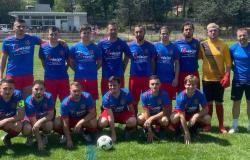In terms of cardiovascular exercise, running is a separate category.
It is a sport that crossed the millennia. The oldest and unique Olympic test was a sprint called Stadion, but its practical advantages date back to prehistoric times.
“To hunt and survive, man had to develop the ability to run millions of years ago. This capacity is therefore anchored in our identity as a species, ”explains Alyssa Olenick, physiologist of the exercise at the University of Colorado Anschutz Medical Campus. “Over the centuries, it has become one of the most popular and accessible sports in the world, both for elite athletes and for ordinary people. »»
“In all age groups, running helps to improve cardiovascular condition, manage its weight, improve bone density, muscle mass and coordination, as well as reducing stress and improving mental Health,” explains Danielle Ponzio, orthopedic surgeon at Thomas Jeffers University Hospital of Philadelphia and co-author of research on running.
Running is not suitable for everyone. Indeed, people with certain pathologies may need to practice exercises without charging, such as swimming. However, this remains a sport that benefits its participants as much today as in Antiquity.
The most regularly studied profit in running is improving heart health. For Allison Zielinski, cardiologist at the Northwestern Memorial Hospital and co -director of the sports cardiology program at the Northwestern Feinberg School of Medicine, this partly means that the heart becomes “a stronger and more efficient pump”. A stronger heart muscle, she explains, improves cardiac output. It is a scientific measure of the quantity of blood that the heart can pump in one minute, that health care providers use to assess the strength and efficiency of a patient’s cardiovascular system.
Zielinski adds that running also affects the autonomous nervous system, the body of the body responsible for regulating involuntary physiological processes such as digestion and breathing, by reducing the heart rate to rest. This is important because studies show that each increase of ten beats per minute of the heart rate at rest is associated with an increase of 16 % of the risk of mortality.
These improvements in cardiovascular performance is one of the reasons why the centers for the control and prevention of diseases in the United States recognize running as a “vigorous intensity” activity, the highest measure of aerobic exercise according to the health agency.
It has also been shown that running improves blood circulation, causing “favorable changes in blood vessels, including an increase in hair density and an improvement in endothelial reactivity, which is called vasodilation,” said Zielinski.
Research shows that running also improves pulmonary capacity and performance, in part by improving the maximum speed to which a person can use oxygen present in his body, a measure known as VO2max. This measure reflects the maximum quantity of blood rich in oxygen that the heart can pump and send to the muscles to stimulate movement.
This has a direct link with the decline in mortality all causes, because “even a small increase in VO2max can have significant long -term health effects,” said Olenick. But it is only many of the longevity markers associated with running.
A significant study carried out over fifteen years and published in the Journal of the American College of Cardiologyrevealed that running if only five to ten minutes a day would save an average of three years of life expectancy. Duck-Chul Lee, co-author of the study and professor of epidemiology of physical activity at the Faculty of Human Sciences of the State University of Iowa, explains that these advantages are due in part to the fact that “running reduces the risk of many diseases and conditions, including coronary disease and type 2 diabetes.”
This activity promotes muscle growth and the increase in bone density, which is particularly important for the elderly. “With age, we tend to lose muscle mass and bone density,” explains Ponzio, “and running exercises are an effective way to counter these losses”. Indeed, a study shows that the semi-stay in particular increases the biological markers of bone formation. »»
In addition, “running can reduce the risk of osteoporosis and arthritis,” said Austin “Ozzie” Gontang, clinical psychotherapist and director of the San Diego Marathon Clinic in California.
Weight management is another advantage associated with running in terms of quality of life. One of the reasons is that running, even at a moderate rate of eight kilometers per hour, knowing that many runners run more than twenty kilometers per hour, burns 590 calories per hour in a person weighing 70 kilograms, as much or more than any other physical activity measured, including swimming, weightlifting, bicycle or basketball. “Running is an effective way to burn calories and is crucial for weight loss and maintenance,” said Gontang.
The advantages of running in terms of mental health are no less fascinating. “Running can be practiced alone, but it often has a social component, whether it is to run with a friend or to be part of a race club or a virtual community,” explains Karmel Choi, clinical psychologist at the Masschussetts General Hospital and the Harvard Medical School. “This is added to the emotional benefits by reducing isolation and increasing the feeling of support and motivation. »»
Activity can also be beneficial to combat depression. Karmel Choi cites a recent study which revealed that people suffering from depression who were starting to run regularly “recovered at a rate similar to that of people who took antidepressants”. Supporting research, she notes that her team estimates that if a person exchanged only fifteen minutes of sitting position against fifteen minutes of running every day, he could “reduce his risk of depression by 26 %”. This is partly explained by the fact that it has been shown that running releases “wellness hormones such as endorphins and dopamine, which have been associated with better mood, reduction in stress and even the euphoria of the runner,” explains Karmel Choi.
In addition to helping to feel better, running is associated with an improvement in cognitive functions. “Running can stimulate brain functions by improving memory and learning capacity,” says Gontang. He explains that this is due to the fact that running increases blood flow to the brain and stimulates the production of a molecule known as a neurotrophic factor derived from the brain (BDNF), “which promotes the growth of new neurons and protects existing brain cells. »»
What is perhaps the most convincing is that the costs are very low and that there are practically no obstacles associated with the practice of this sport. “Running may seem intimidating because it sometimes feels that people need watches, equipment, tools and state -of -the -art shoes to participate, but people can simply start on a road or a path near their home, and often with things they already have,” explains Olenick.
To start, start slowly and then increase your level of shape.
“Try to facilitate the increase in physical activity in your daily life and in the context of the daily activities that you already do, like picking up a little further from the grocery store or taking the stairs rather than the elevator,” suggests Rajesh Vedanthan, doctor and health specialist at Nyu Langone Health in New York. He then suggests going around the pâté de houses while walking with a good step before trying to jog, then running.
Even after getting used to the movement, Lee suggests alternating racing towers with walking or jogging towers. It is also recommended to adopt a correct posture. “Keep your head high and look forward while you run to align your spine,” advises Gontang. It is also important to keep your shoulders relaxed and elbows folded at ninety degrees, and to avoid walking too much.
Establish a race program, find a racing companion (the family dog counts!) And set realistic and measurable objectives are other ways to remain motivated. “It is also important to choose the right type of shoes and adjust them correctly,” advises Ponzio.
As she goes, she suggests listening to her body, avoiding doing too much, too fast, and varying her environment, her terrain and her destination. “Finally, register for races, because the adrenaline gives the fact of participating in something bigger within a community of runners sharing the same ideas is really special,” she said. “The runners ask for them. »»








